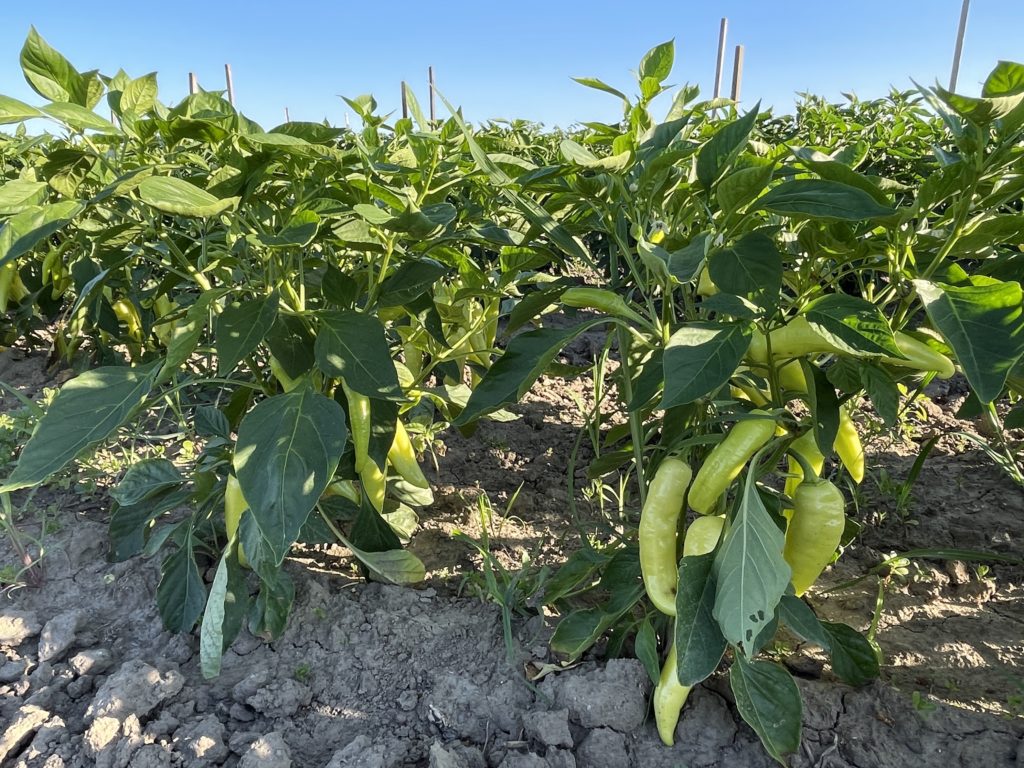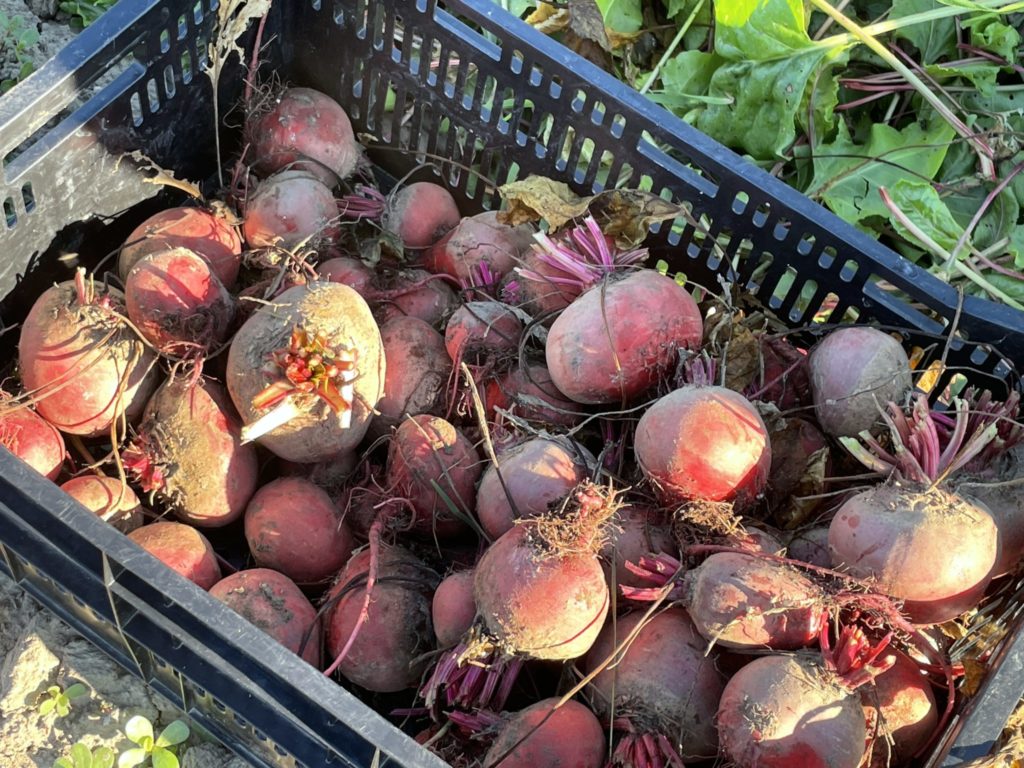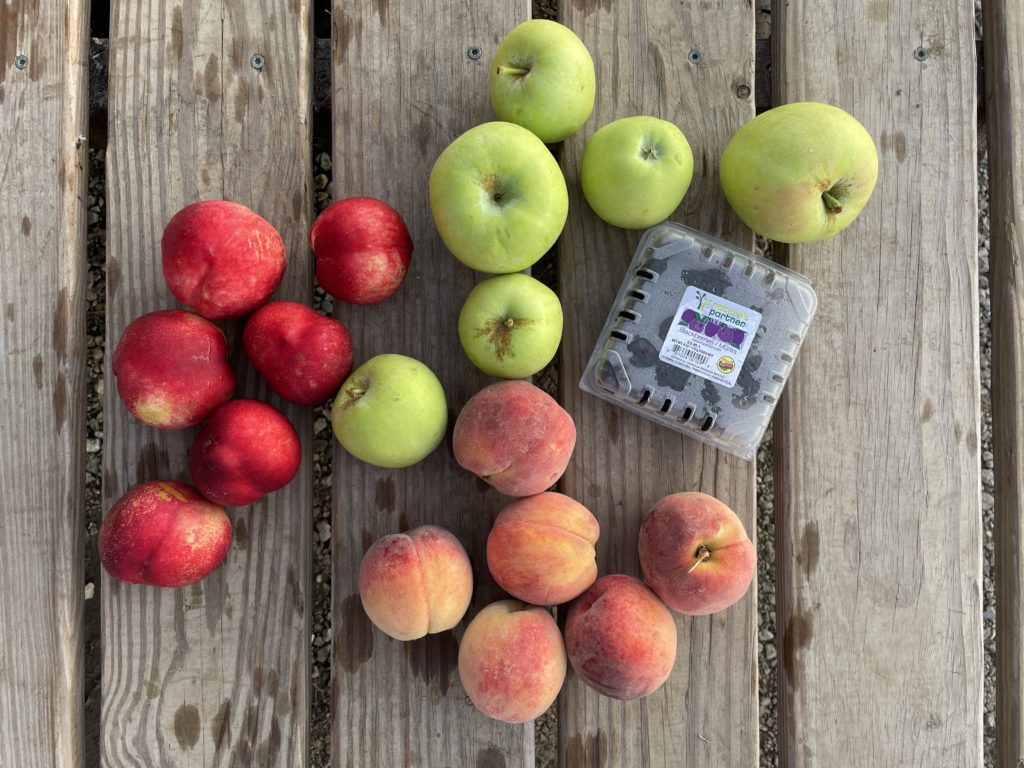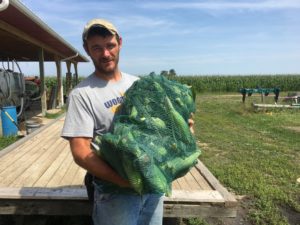Shared Legacy Farms Week 7 Newsletter, August 1-6, 2022
Farm Newsletter Week 7
August 1-6, 2022 | “A” Week

Your farmers at the OshKosh AirVenture show, 2022, in front of the “busiest air traffic control tower in the world.”
What’s in the Box this Week?
TOMATO ~ You will receive either one heirloom or 2 small garden tomatoes. Heirloom tomatoes will have cracks and weird shapes to them. They should be eaten on the first or second day, as they have a very low shelf life — but incredible flavor!! To store: Do not refrigerate tomatoes. Store them at room temperature out of the sun stem side down. Putting them in a paper bag will accelerate the ripening process. Heirloom tomatoes will have strange shapes and cracks. These are highly perishable and should be eaten within 1-2 days. To prep: If you’ll be cooking tomatoes, consider removing the skins so they don’t float around in your dish. To do so, score the end of the tomato with an “X,” dunk whole tomatoes in boiling water for 30 seconds, lift out with slotted spoon, plunge into ice water, and the skins will slide off. To freeze: Tomatoes can be frozen whole with the skin on. The skins will slide right off when they thaw. Simply pop the washed tomatoes whole into a Ziplock bag. Thawed tomatoes are appropriate only for cooking sauces, salsas, or purees.
SWEET BANANA PEPPERS (3) ~ To store: Refrigerate peppers unwashed in a sealed plastic bag in the crisper drawer for 1-2 weeks. To prep: Cut in half and remove the seeds from the inside. Slice, chop or mince. To use: Use as you would a bell pepper! Or try roasting peppers over a flame until the skin blackens. Place the pepper inside a plastic bag to cool. Then remove to slide off the skins. To freeze: Wash and dry peppers. Freeze whole or cut into bite-size pieces and place in Ziplock freezer bag, removing as much air as possible.
JALAPENO (1 or 2) ~ To store: Refrigerate peppers unwashed in a sealed plastic bag in the crisper drawer for 1-2 weeks. You can also dehydrate peppers for long-term. To prep: Be careful when preparing hot peppers of any kind. For greatest safety wear rubber gloves while chopping and handling them. Do not touch your eyes, nose, mouth or other places. Wash hands thoroughly when finished. Slice off the top of the hot pepper, including the stem. Since the heat in chili peppers is concentrated in the seeds and membranes, you can cut out the heat-filled seeds and membranes for a milder heat. To freeze: Wash and dry. Keep whole, or cut into bite-size pieces and place in Ziplock freezer bag.
CANDY STRIPE BEETS (no tops) ~ These beets have a beautiful bulls-eye center that is very eye-catching when served raw. This coloring will disappear when cooked. To store: Store the beet roots, with the rootlets (or “tails”) attached, unwashed, in a plastic bag in the crisper bin of your refrigerator. They will keep for several weeks. To prep: Just before cooking, scrub beets well and remove any scraggly leaves and rootlets. If your recipe calls for raw beets, peel them with a knife or a veggie peeler, then grate or cut them according to the recipe. To remove the skins, you can roast them in foil or boil them, and the peels will slip right off. To freeze: Boil or bake beets until done. Cool them in ice water or let them come to room temperature. Remove peels. Trim the beets into 1/4 inch slices or keep them whole (if they are small). Place in Ziplock freezer bag and remove as much air as possible. Seal and freeze.
Grab my Beet E-book to help you learn more about how to use this root veggie!
SWEET CORN (not organic, non-GMO) ~ To store: Refrigerate sweet corn as soon as possible with husks on. The longer you wait to eat it, the more sugar will turn into starch, and the corn will lose its \ sweetness. To prep: You can eat corn raw or cook it in the husks. Shuck the cob by pulling the husks down the ear and snapping off the stem. The silks will fall off as you cook the corn. Rinse under cold water. If you see a green worm, just cut out the damaged section — the rest of the cob is still edible! To cut the kernels off the cob, stand the cob upright on its base and run a sharp knife from the tip of the ear down to the base. To cook: Steam corn in 1-2 inches of water for 6-10 minutes, or drop ears into boiling water for 3-6 minutes. Season with butter or salt. You can also grill corn in the husk — place the corn in its husk in water for 10 minutes — then place on grill for 15 minutes. To freeze: Blanch on the cob for 3-5 minutes, rinse under cold water, and drain. Cut off the kernels with a knife, and then pack it into airtight freezer containers.
CUT LETTUCE (4 oz) ~ To store: Store unwashed lettuce in a plastic bag in the refrigerator. To store lettuce that you have already washed and dried with a spinner, place back in a plastic bag with a dry paper towel in the bag, and place the package in the vegetable crisper bin. Use within 4 days. To prep: Remove any accidental weeds in the mix. Wash leaves in a basin of cold water. Dry in a salad spinner. To freeze: Not recommended.
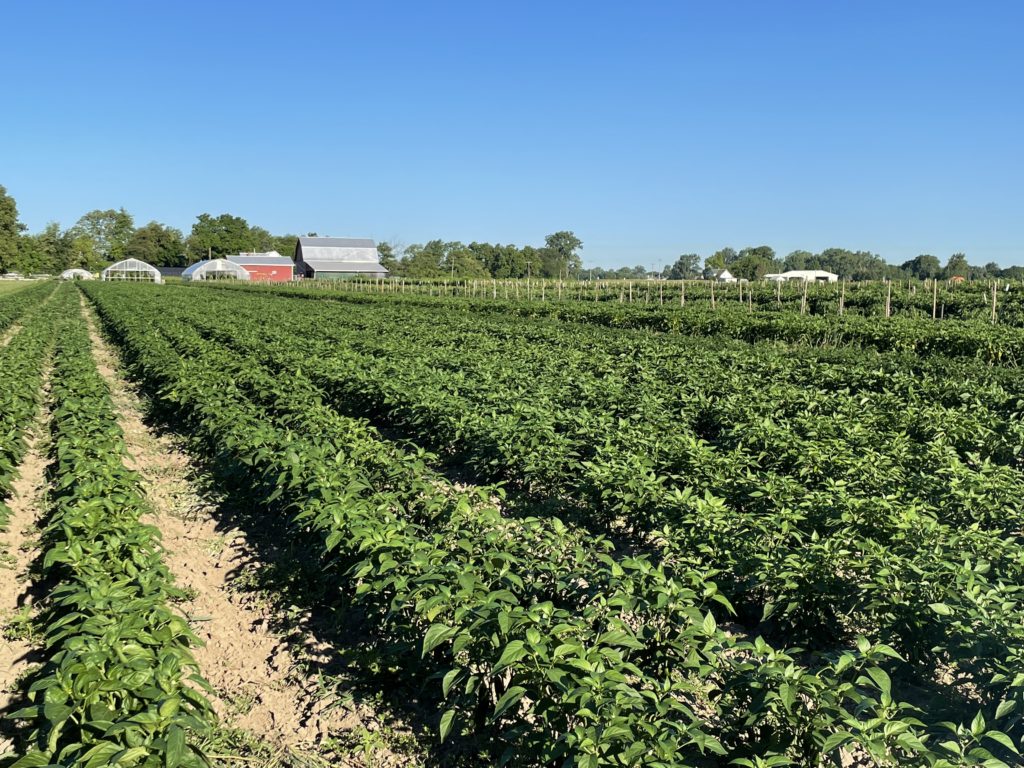
Look at all the peppers! These will be ready in a couple weeks.
GREEN CUCUMBER (1) ~ Cucumbers are in a family known as cucurbits that includes melons, squash, pumpkins and gourds. They are classified as either slicers or picklers. Pickling cucumbers have thin, lighter skin than slicers. To store: Place cucumbers in a sealed plastic bag in the crisper drawer of the refrigerator for up to a week. To prep: Slicing cucumbers are often peeled. Pickling cukes are not. If the seeds are bulky, slice the cucumber lengthwise and scoop them out. Scoring the skin of a cucumber with a fork or zester gives it attractive stripes. Slice, dice or cut into chunks according to recipe. To freeze: You can freeze cucumbers in a vinegar brine, but they will be mushy when you eat them later. Not recommended.
SNACK-SIZE BLONDE CUCUMBERS (3 lb.) ~ Don’t be fooled by the lime-green color of these little cucumbers. They’re supposed to look that way! Follow the instructions above for normal cucumbers. These guys are technically “pickling” cucumbers, meaning they are used to make pickles. But they taste just like cucumbers, and can be the perfect snack-size portion for your lunches.
WHITE SCALLIONS ~ To store: Chop off the top inch of the tender green tips and stand the scallions in an inch of water in a tall container covered loosely with a Ziplock bag, refreshing the water every 3 days. To prep: Remove roots. Chop the leaves and stem before cooking. To use: You can eat the entire scallion. Rinse scallions in cold water and snip off anything that’s floppy. Use chopped scallions as a garnish; they are less pungent. The minced greens of scallions are a good substitute for chives. Use them in stir-fry. Use scallions in almost any recipe calling for onions, raw or cooked. They are excellent in soups and stew. To freeze: Chop into desired size and place on cookie sheet and freeze. Then pop into a Ziplock baggie and store in the freezer. You can even freeze the green tops!
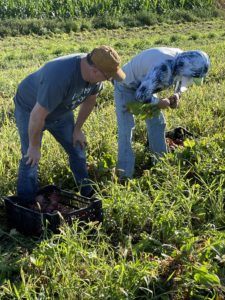
Volunteer Dennis Rodgers helps harvest beets on Saturday on a cool, crisp morning.
CABBAGE ~ Place dry, unwashed cabbage heads in the refrigerator, preferably in the vegetable bin. The outer leaves may eventually get floppy or yellowish, but they can be removed and discarded to reveal fresh inner leaves. Store for up to 3 months! To prep: Rinse the cabbage under cold water before use. Cut cabbage head first into quarters, then diagonally across the wedge. Be sure to remove the stem end and triangular core near the base. To freeze: Choose how to cut your heads based on your end use. Cook in boiling pot of water for 90 seconds. Douse in ice water to stop the cooking process. Drain the cabbage and dry as much as possible. Place in Ziplock freezer bags based on your portions you plan to use, and remove as much air as possible. Put in freezer.
SUMMER SQUASH MIX (4 pieces) ~ This will be a mix of green zucchini, yellow crookneck, patty pan (looks like a flying saucer), and Zephyr (yellow squash with a lime green tip). To store: Store squash unwashed in a perforated plastic bag in the vegetable bin. In the refrigerator they keep for about a week. To prep: Rinse under water to remove the dirt or prickles, and slice off the stem and blossom ends. Then slice or chop. Scrape out seeds from baseball bat sized zucchinis before using them to bake. To use: Slice tender, young summer squash raw into salads. Try them in stir-fry or with pasta. Lightly steam (4-5 minutes) and dress them with fresh herbs or pesto. Or coat squash lightly in oil and roast at 350 degrees whole or sliced in half for 15-45 minutes. Stuff whole squash with your favorite stuffings. Bread them and make zuke fries. To freeze: You can freeze grated zucchini for use in breads and muffins. Squeeze as much liquid out as possible before adding to the freezer bag.
WEEK #7 ADD-ON SHARES: Week “A”
Odd-numbered weeks of our CSA season (week 1,3,5) are called “A” weeks. And even-numbered weeks (week 2,4,6) are called “B” weeks. If you have any kind of non-veggie, bi-weekly share, you have been assigned to either “A” or “B” week for the season. If you get a cheese share, it always comes on Week “A.”
WEEK 7 FRUIT SHARE:
YELLOW NECTARINES ~ To store: If your nectarines are not yet ripe, store them out of the sunlight on the countertop until they are soft and aromatic. Once they are ripe, place them in a plastic bag in the fridge. If you put unripe nectarines in the fridge, you will stop the ripening process! Use ripe nectarines within a week. To prep: Wash. Remove the pit inside.
WHITE PEACHES ~ These will have a white flesh on the inside! Peaches are ripe when they are rich in color, plump, and soft along the seam of the fruit. To store: If your peaches are still firm, store them out of the sunlight on the countertop until they are soft and aromatic. Once they are ripe, place them in a plastic bag in the fridge. To prep: Wash and remove the pit inside.
BLACKBERRIES (1/2 pint)~ (from Niese Farms in Pandora, OH) To store: Store in the fridge in a single layer on a shallow tray covered with a paper towel. Wash them just prior to use, or use a vinegar rinse to kill off bacteria and extend their shelf life. To prep: Rinse gently just before using. Watch out! They’ll stain! To freeze: Choose ripe berries. Wash and sort out the mushy ones. Let dry in colander for 10 minutes. Place them in an even layer on a large cookie sheet and put in freezer overnight until frozen. Then pack them into a freezer bag, removing the air, and seal.
CANTALOUPE (Bench Farms, St. Rte. 2)~ To store: If your cantaloupe melon seems a bit short of ripe, keep it at room temperature for a few days until there is a sweet smell coming from the stem end. Once the melon ripens, then store it in the refrigerator. Cut melon should be covered in plastic wrap. To prep: A big knife and cutting board are helpful. Cut in half, scoop out the seeds, then cut into quarters or slices. Remove the rind.
Ice Cream Flavor of the Week:
SURPRISE! from Knueven Creamery. (Due to the funeral this weekend, we were not able to find out what the flavor would be in advance). Note: be sure to stop and pick up your ice cream from the Knueven milk truck at your pickup site! They will be located either right before or after your veggie pickup. Your farmers will not be passing this out in their delivery line.
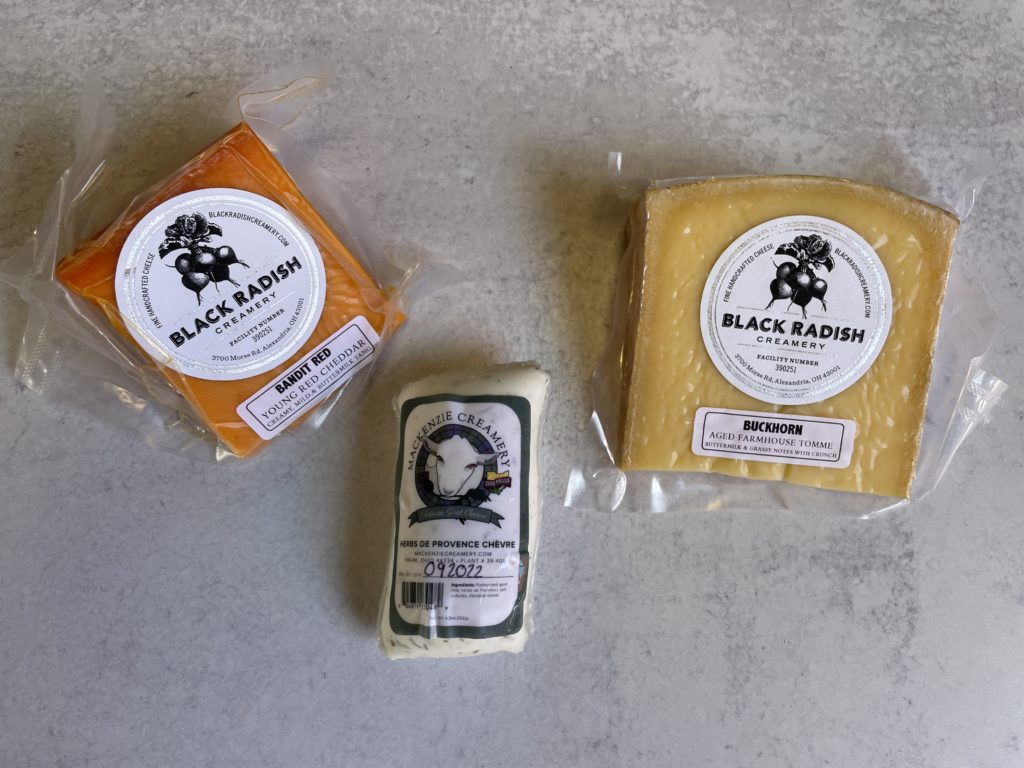
The week 7 Cheese share comes from Black Radish Creamery and MacKenzie Creamery.
Cheese Share:
Bandit Red (Young Red Cheddar) and Buckhorn (Aged Farmhouse Tomme) from Black Radish Creamery
Herbes de Provence goat chevre from MacKenzie Creamery
Coffee Flavor of the Week:
Nicaragua Cafe Diego: Maddie & Bella Coffee Company ~ full body, dark chocolate, caramel
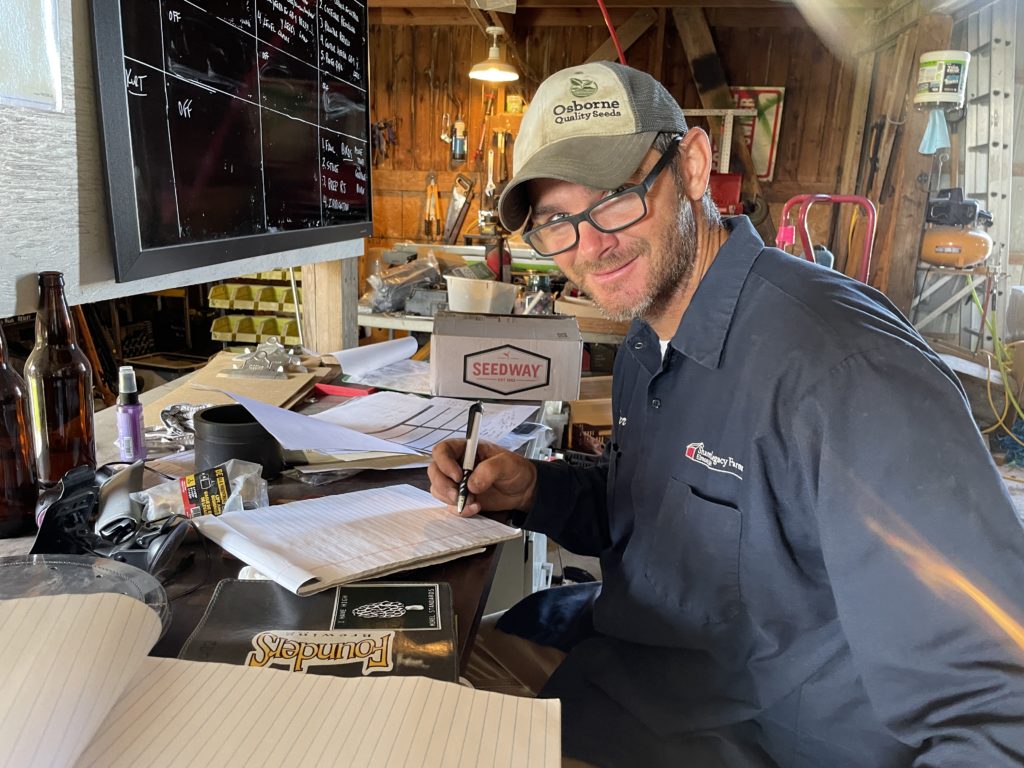
Farmer Kurt works at his desk in the barn, mapping out his plan.
FARMER KURT’S FIELD NOTES
We are back!! What a great time in Oshkosh! Believe it or not, I didn’t think about the farm much while I was gone! I want to say a big thank you to my crew — Noah, Polo, Pedro, John, Jesus, and Jose. I knew the farm was in good hands, and that allowed me to relax and be present with my kids and my bride.
Here are few highlights of the vacation: The EAA AirVenture Aviation show is the largest of its kind in the world. In fact, the air control tower had a fun sign saying: “The busiest air traffic tower in the world” — because for these 7 days, it is! There were so many airplanes — acres and acres of them. Apparently, pilots and aviation enthusiasts from around the country fly into the event and park their plane on the grounds — then tent camp for the week under their wing! You see fields and fields of these planes all around the main grounds. It’s pretty spectacular.
Jed was particularly interested in the War-Birds section. We also saw an Osprey in the main square on day 2. Every day at 2:30 PM, there would be a 3 hour air show — featuring different aerobatic pilots — like a helicopter that could fly inverted and do barrel rolls! Corinna would find the shade of an aircraft to sit under and watch the show. Jed came home and started looking up ultralights for sale on the internet — his next goal is to buy one and fix it up this next year. We’ll see…

We saw lots of WarBirds at the Oshkosh Air Show.
It sure was good to see Harley again! I’m not sure who missed each other more! She has become much better at listening. We now trust her to go outside on her own without a leash, and not run away. She has learned where the sweet corn field is. I catch her running over there, pulling the entire stalk out with her mouth, and then dragging the whole plant back to the house to munch on the ear, which she will eat in its entirety.
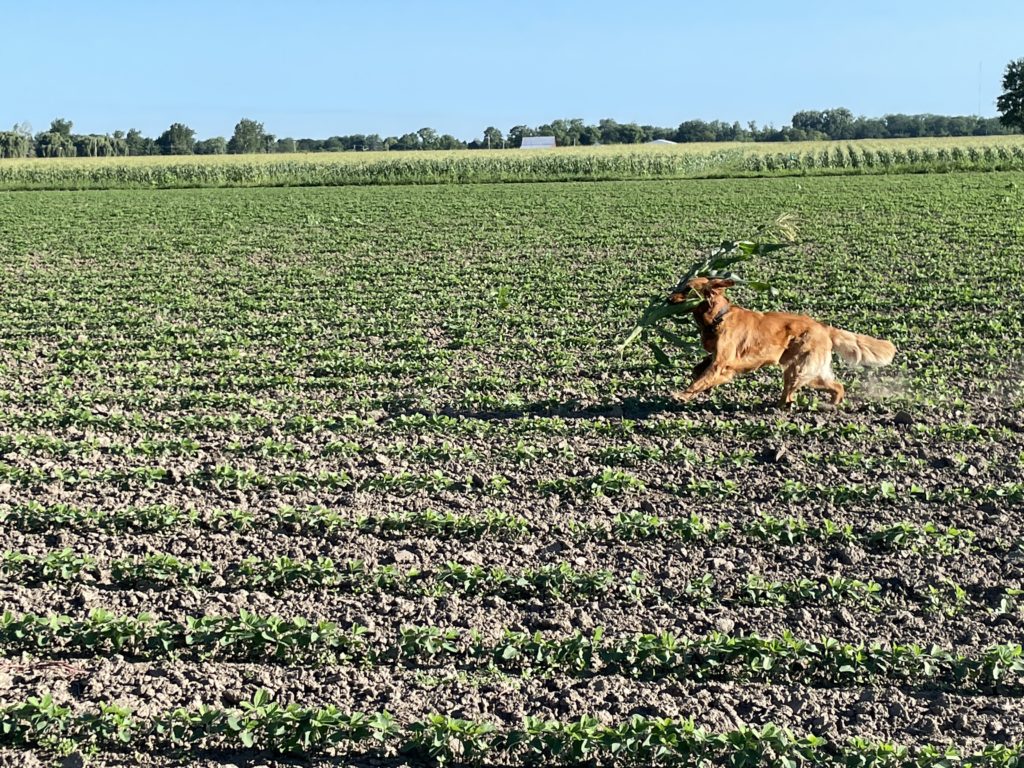
Caught in the act! Harley steals a corn stalk from the sweet corn patch and brings it back to her lair to enjoy.
Upon our arrival home on Thursday, I went to work picking melons. My crew spent most of the week weeding and harvesting sweet corn and melons. There is a LOT of food out in the field, and I’m going to need some help this week harvesting it all — since Noah will be gone at the fair all week. Want to help out on Monday? Let me know!
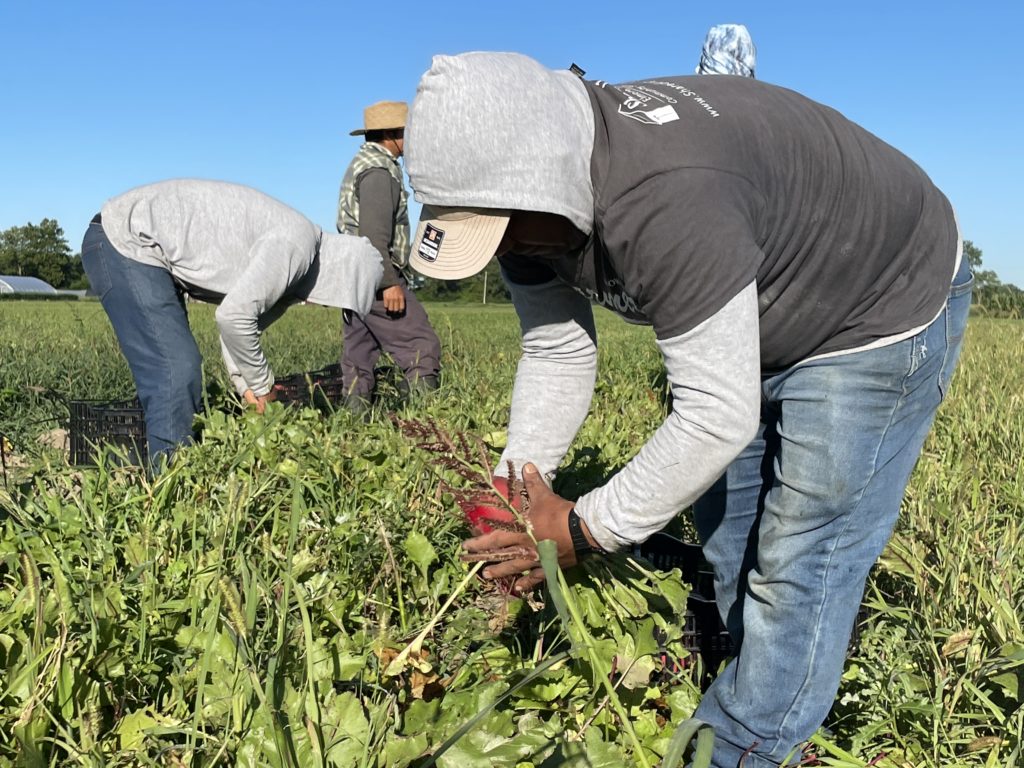
Pedro harvests beets, twisting off the tops one by one.
We had in influx of zucchini this past week, as the 4 rows just kept producing. Without an outlet for them, I ended up donating most of it, and I told the guys not to harvest one of the beds while I was away. I may regret that decision, but it doesn’t make sense to spend labor hours harvesting a crop that I can’t move. Even my CSA wouldn’t take that many summer squash!
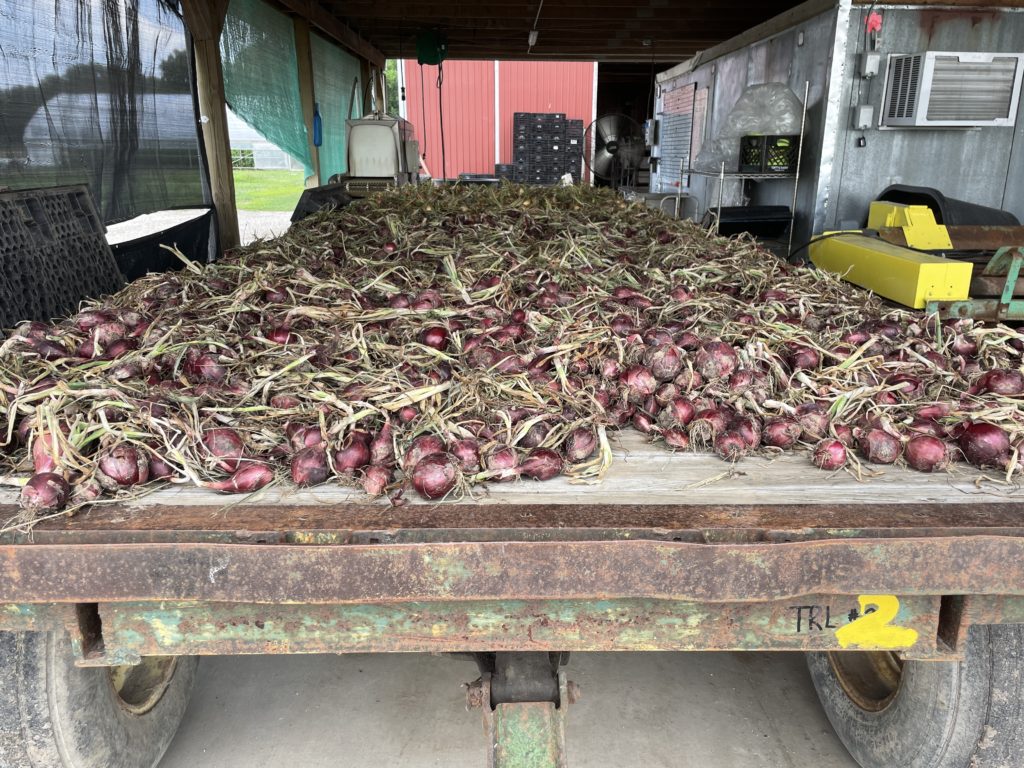
Onions lie curing on a wagon under the wash bay last week.
Eggplant and peppers are coming along. You’ll likely see those very soon. The cherry tomatoes are starting to turn color at the bottom of the plants. I’m watering my winter squash this weekend — we could use a little rain again. The peppers need weeding. And our red onions are curing nicely under the pack shed wash bay.
My neighbor Josh came through and cut the rest of the rye down and baled it this week. So there’s a nice clear view again across the field. My asparagus crop may look like it’s taken over by weeds, but don’t be fooled. I planted a cover crop between the rows to serve as a weed suppressant. It’s keeping out the weeds and adding good stuff back into my soil. I’m very pleased with that hack I learned from YouTube!
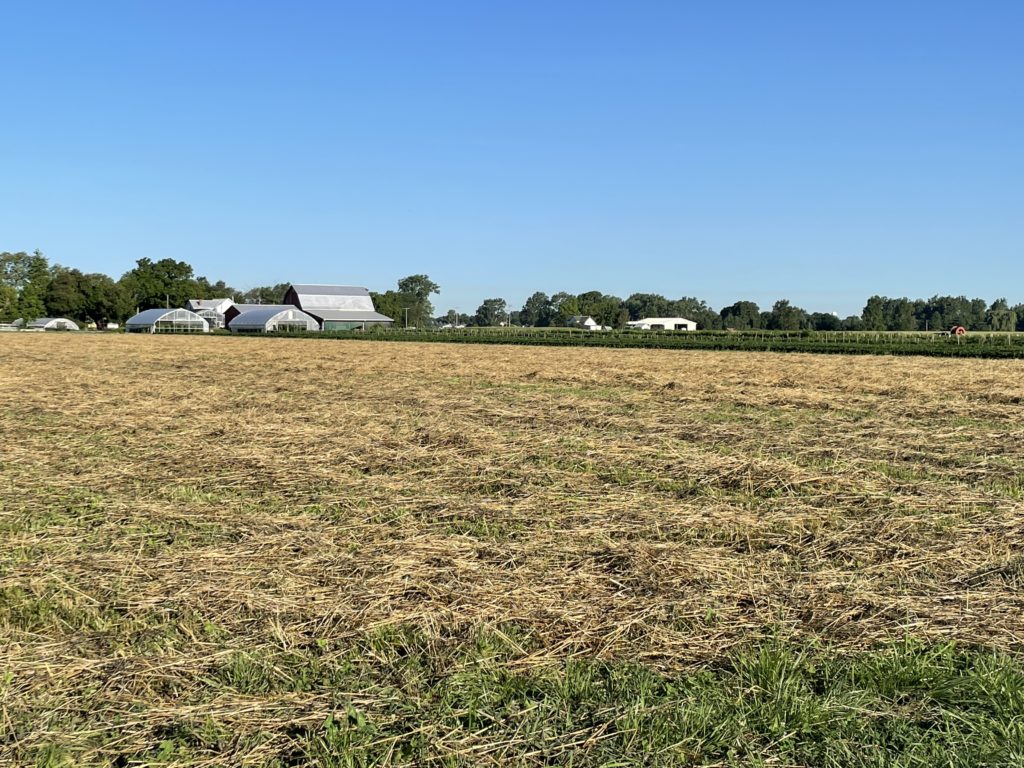
The rye was cut exposing a beautiful view from across the field.
Corinna’s other brother, Sven, from Portland is arriving on Monday with 2 of our nephews to hang out on the farm until Thursday. This has been the year of family visits!! They’ve never seen the farm. James and Jack are in 3rd grade and kindergarten — so I’m pretty sure they’re going to have a glorious time playing outside on the farm with their cousins.
Our condolences to the Knueven family, who lost their great patriarch this past week. Charles (“Charlie”) Urban Thomas Knueven passed away on July 24th. Please give their family some grace this week.
~Your Farmer, Kurt
Menu Announced for Field to Table Dinner
Order Your Ticket Reservations Now for Sept. 10
You can now place your reservations for our final Field to Table dinner, to be held on Sept. 10. You may arrive at 5 PM to stroll our fields and take one of our 3 scheduled tractor hay ride tours. Dinner begins at 6 PM. Dress comfortably — it may get a bit chilly when the sun sets. This event will be catered by Cork and Knife Provisions (Chef Joseph Jacobsen –formerly of Degage Jazz Cafe), and will be held outside in the middle of our field. It will be a sit-down meal, served by a wait staff. The menu include 5 courses, which you can see below. Fizzitap Vintage Beverage Truck will also be in attendance, ready to serve you 2 fun mocktails from 5-8 PM at no extra charge. No alcohol will be served. However, you are encouraged to bring your own beer or wine. Tickets are $75/person. To place your reservation, head to this link to pre-pay. You may at that time also request a vegetarian option if needed. Tickets are first-come, first-serve. You are welcome to invite friends who are not in the CSA.
Here is the menu:
5-6 PM: Noshes, Nibbles & Fresh Mocktails (from Fizzitap Vintage)
Greens + Corn & Pollen:
Coal roasted chard & kale, sweet corn & smoked farm cream chowder, bacon foam, crystalized jalapeno & poblano, foraged aromatics, bee pollen.
Carrot + Squash & Maters
Late summer squash & carrot fritters, greens & field tomato, scratch ranch tzatziki, raindrops of peach & maple vinny, smoked salt.
Sea + Chips
Fire roasted wild lobster roasted on wood over coal pits & fire, late summer succotash, malt vinegar smoked aioli, olive oil tater & squash chips. ( Veggie Option available )
Roots + Swine & Rose
Local honey & harissa roasted farm root veg, labneh, scratch-preserved lemon & rose, crispy skin swine spit-roasted in the field over cedar branchlets & coals, hasselback potatoes, cider & farm butter jus. ( Veggie Option Available )
Chocolate + Shuck & Smoke
Marquise smoked chocolate mousse cake, bruleed Cinnamon sweet corn ice cream, fermented ground cherries, CO2 infused crystalized mint.
To place your reservation, head to this link to pre-pay.
How to Freeze Sweet Corn
Many of our CSA members freeze a bushel bag of sweet corn each year. It’s super easy to do, and in this video, I show you how it’s done! Sweet corn is for sale for the rest of this month in our online store for $35/bushel. That’s 64 ears.

Sweet corn season! Are you starting to run out of ideas?…
Do You Know the Difference Between Sweet Corn & Field Corn?
Plus We Answer the Question: “Is Your Sweet Corn GMO?”
This week, during our vacation travels, we were driving through Wisconsin’s rural roads and saw a passenger hop out of a car parked along the side of a corn field. He was scavenging (“stealing”) some corn from the field and bringing the ears back to his car. As farmers, we obviously don’t like seeing that sort of thing, but we found ourselves chuckling to ourselves in the car, as Kurt said rather snarkily, “Yeah buddy, hope you know that ain’t sweet corn!”
The guy didn’t know he was actually stealing field corn — which is totally gross to eat. We all had a good laugh as we passed him by.
I’m always surprised at how many people don’t realize the difference between field and sweet corn, considering how much of a staple both these crops are in the American diet. If you came out to our parents’ fields and actually looked at the two different plants, you would see a noticeable difference in their physical characteristics. (For your information, Shared Legacy Farms doesn’t technically grow any corn at all. We buy in the sweet corn from our parents Bench Farms St. Rte 2. Because it’s not organic, we bag it up and pack it separately from the rest of our CSA box.)
Today I want to review with you the difference between sweet corn and field corn, so that you can educate your friends around you. Or you can watch this video on YouTube that Corinna made last year.
Sweet corn is what we commonly think of when we picture eating corn on the cob or frozen corn from the freezer aisle. Sweet corn is grown for human consumption. The plant stalk is about 5 feet tall. It is planted in mid-April, and usually “tassels” and begins forming its ears at the end of June. We don’t usually harvest it until mid-July at the earliest. We plant multiple succession crops, so that we can enjoy sweet corn through September. All the sweet corn is picked by hand, although we do use a conveyer machine called “Veg-Veyer” to make things a bit easier. A tractor pulls this conveyer belt system behind, and the pickers walk down a row, pulling 1-2 ears off each plant and throw them on the moving conveyer belt in front of them. This belt then takes the corn ears up to a giant storage box, which is eventually placed in a cooler until it is packed. You can watch this video to see how it’s done!
Kurt wakes up nearly every morning of sweet corn season to help the crew pull corn for about 1.5 hours. They like to do it early before it gets too hot. The fields are often soaking wet with dew, so our pickers will wear protective clothing — sometimes even waterproof jackets to keep from getting wet and itchy. It’s exhausting work though, and it soon becomes a chore after a few weeks. It takes an experienced hand to “feel” whether a corn husk is ready for picking. If the tops feel plump, indicating the kernels have ripened all the way up the ear, then it’s ready to pick. If the ear isn’t ready, it’s passed by, and left behind (and often not picked later, truth be told). Having a good crew in the picking zone is critical to getting this job done well. Fast pickers really help move the project along and keep the crew motivated.
Sweet corn is hard to grow because of the pests that like to eat them. Moths like to lay their eggs in our sweet corn — you may find an occasional worm at the tip. If you do, just cut off the tip –the rest is still edible and delicious! Our parents spray the corn to prevent worms — or it would be much worse — which is why it’s not organic. Birds also love to eat the tips of the corn. We are currently dealing with a swarm of blackbirds that is decimating our early crop of sweet corn; all it takes is a few pecks on the top ear to make it unworthy for market.
The field corn plant is grown primarily for animal feed and processed foods — basically anything with the ingredient “corn syrup.” The field corn stalk also grows significantly higher than its cousin — about 9 feet high, and farmers don’t harvest it until the fall, when the corn plant has died. At this time all of the plant is brown and the ears hang down. The corn husks likewise have lost most of their moisture, with the corn kernels looking dehydrated and ready to pop off the cob. It is then that you see the army of combines coming out in the field to “shell” or cut the corn. This dried corn is then loaded into grain trucks and hauled to the grain elevators for sale, or stored locally on the farm in a silo to feed to animals over the winter.
Corn that is sold to the grain elevators (like the Andersons or Archer Daniels Midland in Toledo) is often stored for long periods of time, and shipped via vessel across oceans or over land by rail. Each grain elevator has a U.S. inspector inspecting the corn as it is loaded onto vessels, making sure that it passes certain food grade levels. A certain percentage of damage (spoiled product) is allowed, so the grain elevators are always blending in as much “bad” product as is allowed so they can maximize profits. (This used to be Kurt’s job at ADM).
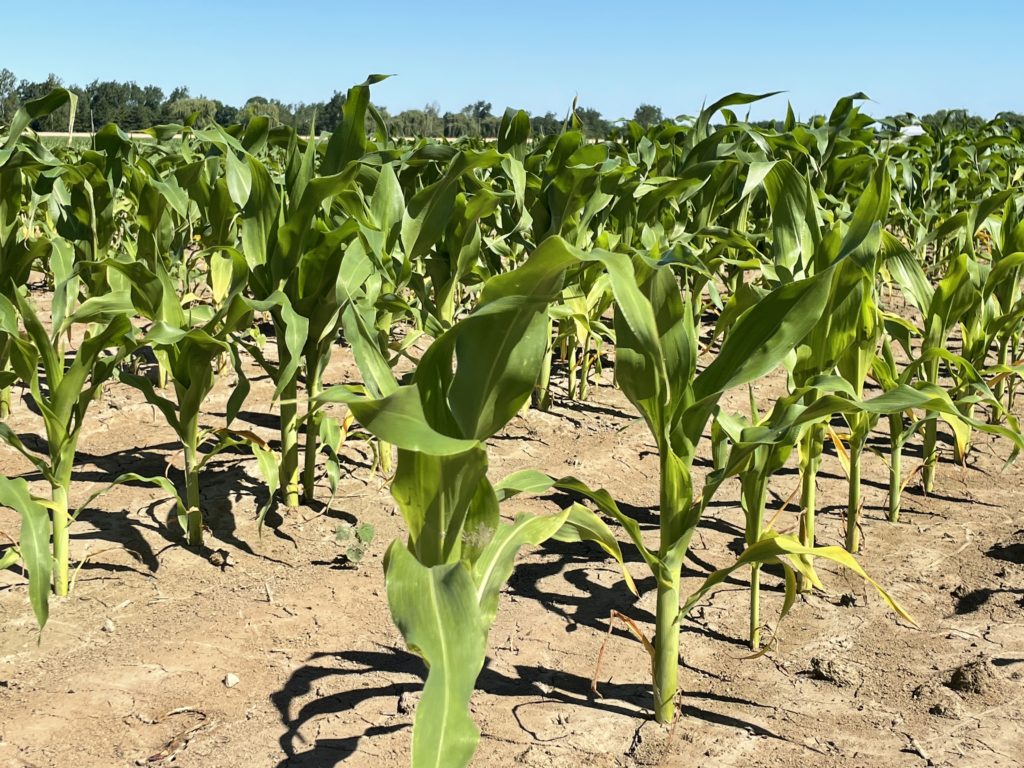
The first batch of sweet corn.
In America, almost all of the field corn that is planted is GMO. The reason for this is that farmers want to be able to spray this corn with Roundup (an herbicide containing the active ingredient glyphosate). Roundup kills everything it sprays — except the corn plant itself, because the seed has been genetically modified to resist the poison. An interesting debate revolves around the use of this GMO seed in our country, because trace amounts of the by-product of this plant ends up in our food chain — either in beef, pork, or chicken, or in processed foods. Take a look at your food ingredient labels… anywhere you see “high fructose corn syrup,” or “corn starch,” you’re consuming this field corn.
We are often asked, “Is your sweet corn non-GMO?” Our sweet corn is NOT a GMO. But as farmers, we find this an amusing question, and here’s why. It is impossible to buy sweet corn seed that is GMO — it doesn’t exist (yet)! All the hype around GMO seed refers to field corn — but many Americans don’t understand the distinction between the two plants. As a result, you’ll often see signage at farmer’s markets labeling their sweet corn “non-GMO” — as if there were a GMO version! This creates a lot of confusion in the marketplace.This is likely happening because farmers are tired of explaining to consumers the bigger story. So don’t fall into this marketing trick! All sweet corn is non-GMO.
However… if consuming GMO food products is a concern for you, then you should avoid any processed food product that contains “corn syrup” or “corn starch.” These products are made from ground up field corn, which is most assuredly GMO. I think you’ll find that avoiding corn syrup is extremely difficult in this country — it’s everywhere in our food supply. A sobering thought….
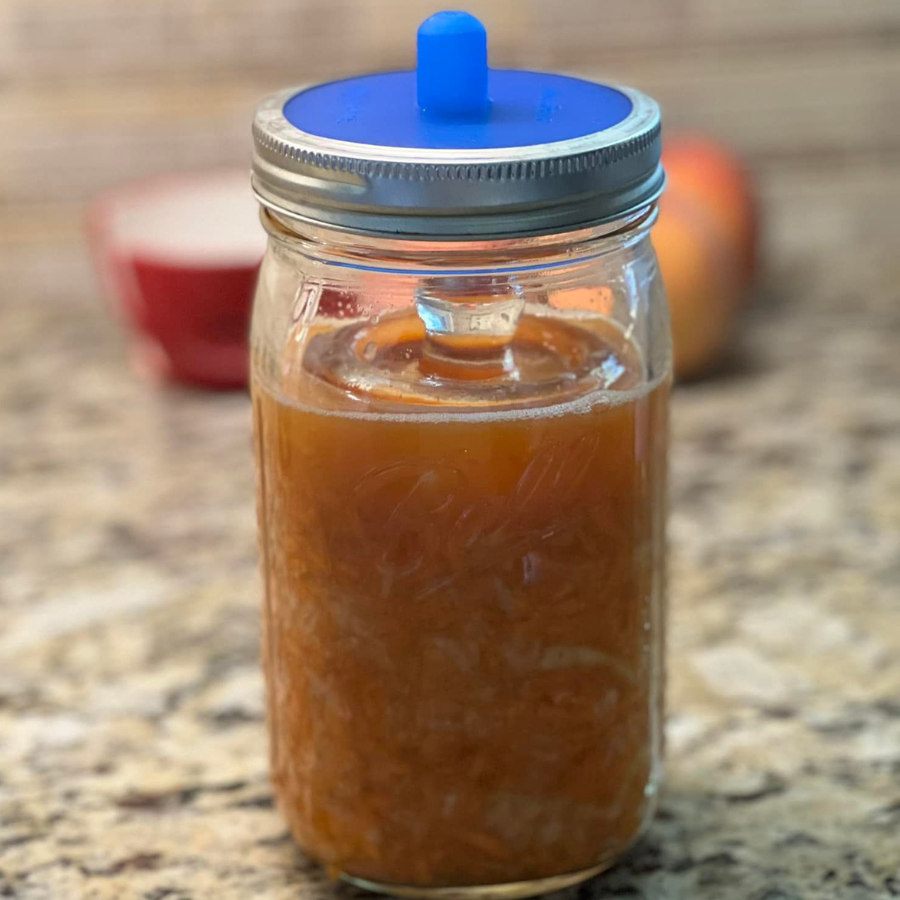
Kay Siegel shared this fermented ginger kohlrabi slaw idea — kohlrabi seemed to stump folks this week!
WEEK 7 ANNOUNCEMENTS
- SAVE THE DATE! Our end-of-year Farm Dinner of the year will take place on September 10th. It will be catered by Cork and Knife Provisions under the watchful eye of Master Chef Joseph (formerly of Degage Restaurant). Tickets will be $75 each. There are currently 65 seats available. See our special article in this newsletter with details and menu. You can reserve your spot here.
Bulk corn comes in a bag like this of 5 dozen ears for $35.
Sweet corn is now available to buy in bulk in our online store! A bushel bag goes for $35 and includes 64 ears. We encourage you to buy your bulk corn in August, because the ears are bigger then. We only have a limited amount of space on our trucks, so if we sell out, just hang on tight and be ready to order next week. OR, you can email us and request a special pickup at the farm that week. We can accommodate any amount of bulk orders right now if you’re willing to come out to the farm to get it.
- Congratulations to our 3 winners of the CSA Bingo Contest! Angie Patchett, Val Washeck, and Michelle Perkins-Cole will each receive a gift bag of olive oil and balsamic vinegar from the Olive Scene in Vermillion.
- Watch our weekly Live Unboxing video this Tuesday around 8 PM inside the private Facebook group. Cadie Jardin, our CSA coach and dietitian, will show you what’s in the box, share storage tips and ideas for how to use your product. You can find the Facebook group at this link. If you aren’t on Facebook, we download the unboxing video into the digital Academy library (which you all get free access to). Reach out to me if you can’t figure out how to get into the Academy. (www.sharedlegacyfarms.com/academy) — note: you should NOT pay for a membership to the Academy. You get in for free with your membership!
- You can order additional items from the Shared Legacy Farms online store. Our store link is super easy to remember: www.sharedlegacyfarms.com/store. Just be sure to select the right pickup site that coincides with your pickup location. If the pickup option is greyed out or not available, it means you missed the window to order. You need to place your order 36 hours before your site. We harvest the product on Monday and Wednesday mornings — early. This week, the store will have: sweet corn, bulk sweet corn, carrots, green cucumber, Armenian cucumbers, jalapenos, basil, candy stripe beets, golden beets, red beets, cantaloupe, scallions, dinosaur kale, green cabbage, summer squash, green kohlrabi, blonde pickling cucumbers, dill flower bunches, blackberries, yellow peaches, along with my brother Arik’s honey, local maple syrup, rye flour, and a few extra eggs from Jed/Josiah.
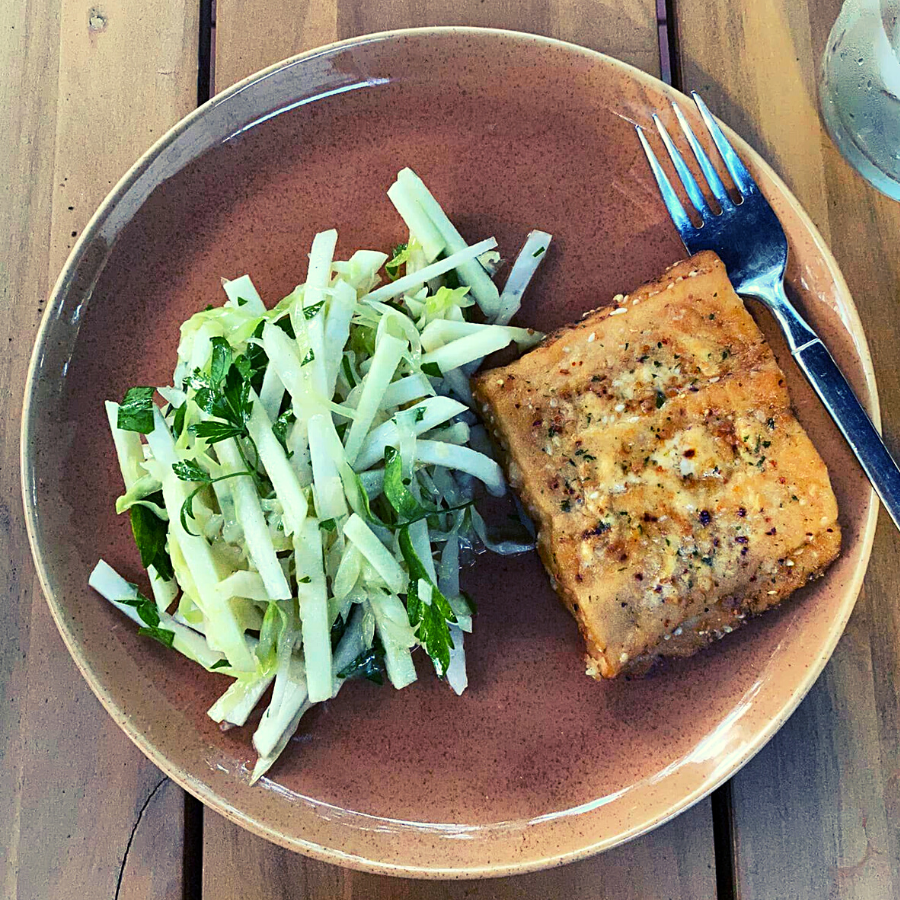
This apple kohlrabi slaw was shared by Ellen Rodriguez.
WEEK 7 CSA RECIPES
Members: You can download these recipes as a PDF here. These recipes are designed to inspire you to use your box this week! Please check inside our private Facebook group to find your fellow members sharing ideas for what to make with their box! Share a photo and you might be featured in next week’s newsletter!
20 Minute Skillet Sausage & Zucchini
Almond Flour Zucchini Bread
Southwestern Black Bean Corn Salad
Grilled Summer Squash with Lemon Scallion Dressing
Grilled Cabbage with Bacon
Jalapeno Popper Creamed Corn
Quick Pickled Beets and Onions
Tomato, Cucumber and Red Onion Salad
Raw Beet and Cucumber Salad
Savory Cabbage Pancakes
Honey Lime Tilapia and Corn Foil Pack
Grilled Jalapeno-Lime Corn on the Cob
Basil Vinaigrette
Peach Crostata
Cantaloupe and Black Pepper Granita
Iced Melon Mint Tea

